14 December, 2003
Road to Minna Bluffs
The day started very early as we still had a lot to do
before leave. We had to unload the cage, drag our
cargo down to the ice, and tie them on to the sleds.
Unfortunately, it was not the best weather for riding
on a snowmobile. The sun spent most of the day hidden
behind clouds, making it very cold and the winds were
quite strong. We made a point to keep an eye on each
other's noses and cheeks, when we stopped to stretch
our legs or stop for a bite to eat. What were we
looking for/worried about?
The trip to MB is about 80 km and takes roughly four
to five hours by snowmobile. Riding a ski-doo is fun
for the first hour or two, but then is very tiring.
The movement is a cross between riding a mechanical
bull, driving a motorcycle, or maneuvering a wave
runner on rough seas. The sastrugi, ridges of the sea
ice carved out by the wind make for a rough surface
and one gets bounced backwards and forwards, up and
down, and side to side. In addition, your thumb and
wrist hurt from continually having to hold the
throttle. It took me a bit to realize that you have to
relax and move with each bounce, even if you feel like
you are going to tip. I spent much of the trip
hunkered down tensing nearly every muscle, resulted in
a horribly stiff back and neck.
As the afternoon progressed the weather continued to
get worse. The clouds thickened; blocking what little
sun we had which made it nearly impossible to see the
definition of the road below us. I found this very
uncomfortable, as it was not easy to see upcoming
bumps.
The wind had picked up, resulted in blowing snow. As
we bounced around completely isolated from the rest of
the world, I thought to myself, this is the "real
Antarctica", or at least the one everyone envisions
when they think of this place.
As we approached our planned camping site we encounter
huge pressure ridges caused by the glacier moving
around the landmass. Some of the ridges (which look
like frozen waves) were nearly fifteen feet tall.
Climbing the ridges while dragging sleds was an
impossible task. Ski-doos started leaving cracks in
the ice and sleds began to tip. After tying to make
our way to land, we finally decided that it was not
worth crossing the ridges and instead turned around to
camp on the snow.
While I must admit I was a little nervous throughout
the whole ordeal the whole experience was so surreal.
The view through my goggles was almost dream like.
White clouds covering both the sun and the mountains
met the icy blue pressure ridges creating almost a
magical land. I kept waiting for fairies and unicorns
to appear from the clouds. It was truly beautiful and
a view I hope never to forget.
After finding a suitable place to camp, we very
quickly had to apply many of the skills we learned at
happy camper school. The first task was setting up
shelter. The strong winds and blowing snow made
setting up the tents much harder than they had been
during our training class; and the importance of the
dead man anchor became more relevant. Once our tents
had been pitched, our gear was brought in, snow was
melted for water, and chef Regina began fixing supper.
It was close to 8:30 and we were all exhausted after
such an extremely long day. Tired and sore, Barb and I
soon retired to our Scott tent and fell asleep as the
wind continually flapped the walls of our tent.

1. A map of the Minna Bluff area. McMurdo station is located to the north. (Just off the map and more towards the right side of the page). We traveled between White island and Black Island and camped on the ice shelf about 7km from the Minna Bluff mainland. Were we camping on fresh water or salt water? The big mound just to the West of Minna Bluff is Mt. Discovery.
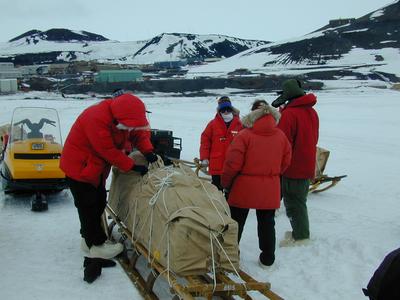
2. Packing the sleds
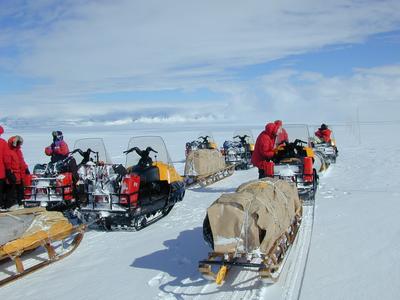
3. The road to Minna Bluff. Notice the poles on the right. These mark the roadE

4. Scott and Laurie model the needed attire when snowmobiling. Why must we wear so much protection on our face?

5. A change in the weather.
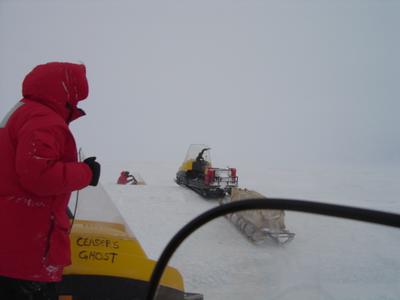
6. Traveling up over the pressure ridges

7. Another sled has just tipped and other members of the team are walking back to assist them.
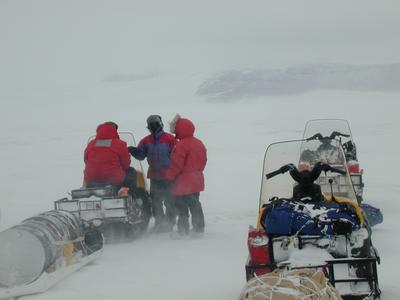
8. Deciding to turn back.
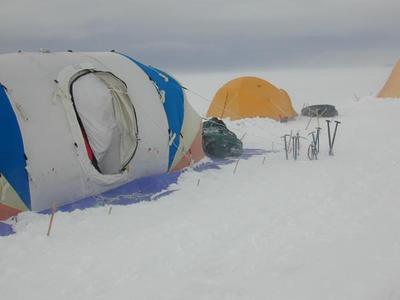
9. A view of our camp. The colorful tent is the cook tent. The mountaineering tent is for sleeping and the Scott tent is the latrine. Not seen in this picture is a second mountaineering tent and a Scott tent, which will also be used for sleeping.
Contact the TEA in the field at
.
If you cannot connect through your browser, copy the
TEA's e-mail address in the "To:" line of
your favorite e-mail package.
|
